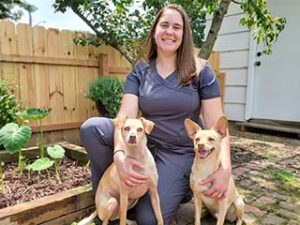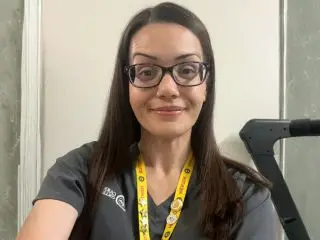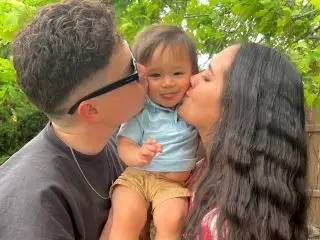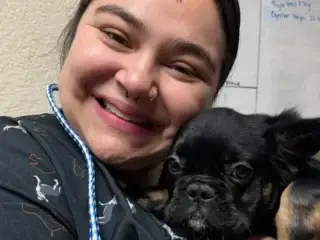 As a young girl, Jenna Micolta loved animals. For years, she dreamed of having a career in which she could help provide care for them. Today, that’s exactly what she’s doing. In January, Jenna graduated from Carrington College’s Stockton, California campus with her Associate of Science degree in Veterinary Technology. The previous month, Jenna’s husband, Johan, completed his service in the United States Coast Guard, and the couple decided to return to their family and friends in the Midwest. With their two dogs and two cats in the back seat, they drove from Northern California to Quincy, Illinois, where Jenna, 30, started her new job as a veterinary technician just a week after arriving in town. We talked with Jenna about her decision to return to school after already earning a bachelor’s degree, what appeals to her about working with animals, and how she applies the knowledge she gained at Carrington every day in the veterinary clinic where she now works.
As a young girl, Jenna Micolta loved animals. For years, she dreamed of having a career in which she could help provide care for them. Today, that’s exactly what she’s doing. In January, Jenna graduated from Carrington College’s Stockton, California campus with her Associate of Science degree in Veterinary Technology. The previous month, Jenna’s husband, Johan, completed his service in the United States Coast Guard, and the couple decided to return to their family and friends in the Midwest. With their two dogs and two cats in the back seat, they drove from Northern California to Quincy, Illinois, where Jenna, 30, started her new job as a veterinary technician just a week after arriving in town. We talked with Jenna about her decision to return to school after already earning a bachelor’s degree, what appeals to her about working with animals, and how she applies the knowledge she gained at Carrington every day in the veterinary clinic where she now works.
You earned a Bachelor of Science degree in Biology from Hannibal-LaGrange University in Missouri eight years ago. Why did you decide to return to college for an Associate of Science degree in Veterinary Technology?
After I graduated with my BS in Biology, I joined the United States Coast Guard and served for four and a half years. When I left the Coast Guard, I was looking for jobs in which I could utilize my biology degree, but my degree didn’t position me for any specific job. I decided to return to school because wanted the specific training and education that would prepare me to work as a veterinary technician. Carrington’s Vet Tech program is focused on teaching and developing the practical, hands-on skills you need to get a job as a veterinary technician. It’s possible to become a vet tech without a degree or certificate as long as you pass the licensing exam, but it’s much more difficult to gain the knowledge and experience you need without the education and training that the program provides.
While you attended Carrington, you worked as an Assistant Animal Care Specialist at the Micke Grove Zoo in Lodi, California. Do you think the knowledge you gained in class made you a better zoo employee—or did working at the zoo help make you a better student?
Both! For a year and a half, I was able to directly apply the things I was learning in class at my job at the zoo. I also gained a lot of practical experience at the zoo that made me a better vet tech student. For me, working at the zoo was a dream come true. I applied a year before they called me for an interview, and I was so thrilled to get the job. I was three months into my Vet Tech program when I started at the zoo, so my life was very busy. Fortunately, they were willing to work with my school schedule. I averaged 16 to 20 hours a week, and I did a little of everything. I monitored the health and well-being of animals, provided routine health care under the direction of a veterinarian, and prepared and distributed meals to the animals. I also assisted in cleaning and maintaining animal exhibits and veterinary facilities, and assisted in providing animal enrichment to simulate natural conditions. I really loved my experience at the zoo—and I miss it!
You were in the middle of your program when COVID changed everything in March of last year. What was it like for you to suddenly be attending classes remotely?
If was definitely different, but I enjoyed the entire experience. My instructors and everyone else at Carrington did a great job at adapting and doing their best during difficult circumstances. There was one term when we weren’t on campus at all, so we would stop by campus to pick up supplies that had been prepared for us. We videotaped ourselves scrubbing in for surgeries. I practiced bandaging techniques on one of my dogs. We practiced applying a catheter on a pool noodle with rubber hosing. Some of the processes were very creative. They were simple but effective. I think our class also learned a lot about being resilient and going with the flow, which are both valuable skills when you’re working in a veterinary office. It’s a 19-month program, but it felt so much faster because there was so much going on.
What was your externship like?
I externed at a pet clinic and hospital in Stockton, and it was everything I hoped it would be. I started during the pandemic, and since it was a small practice, I got to do a bit of everything. One day I was scheduling appointments at the front desk or trimming cat nails, and the next day I was administering vaccines, producing diagnostic radiographs, and assisting the vet in emergency surgery. When my externship ended, they hired me and I stayed on for a few additional months before I moved back to the Midwest.
You returned to Illinois after completing your degree and you were hired as a veterinary technician after a video interview before you even arrived in town. How are you liking it?
I love it. I like the fast pace and the variety, and I find that I’m applying what I learned in my program every day. I get to work every morning a little before 8:00 a.m. and I’m busy all day. I’m doing a little of everything—wellness exams, orthopedic exams, booking appointments, checking prescription refills and lab results, helping with surgery intakes, prepping patients for surgery, and monitoring the overnight patients. One of the vets in the office specializes in exotic animals such as birds, lizards, and snakes, so my experience working at the zoo has been valuable. I’m also training to assist in orthopedic surgeries. I love scrubbing in for surgeries. In this field, you’re learning something new every day.
What would you say to someone who might be considering the Veterinary Technology program at Carrington?
It’s really a great program and I’m grateful I did it. I think one of the reasons the time seemed to go so quickly is that the program is very focused. I never felt like any time was wasted, and I graduated feeling very prepared. I still have a lot to learn, but I feel like Carrington provided me with a solid foundation I can really build a career.



